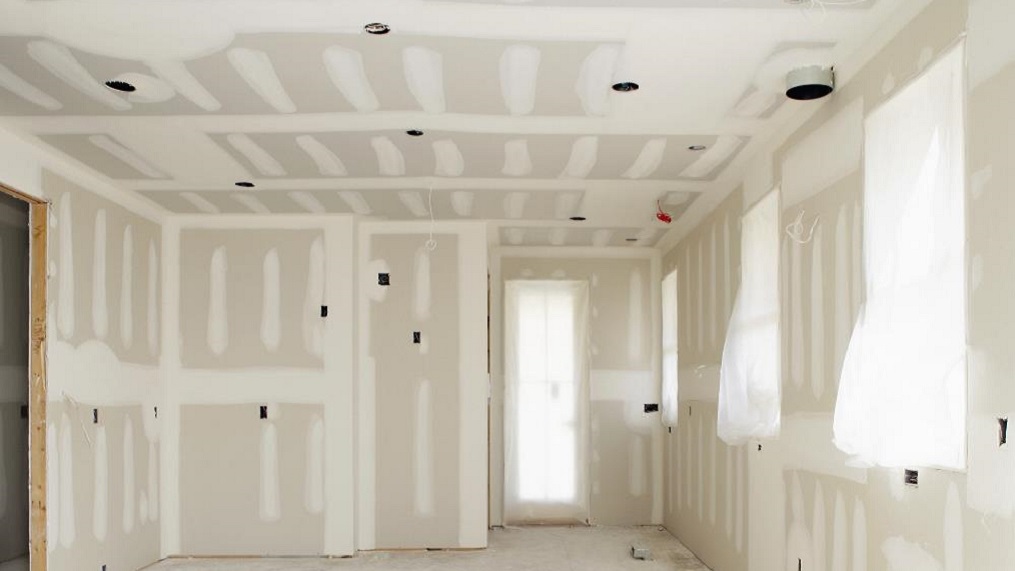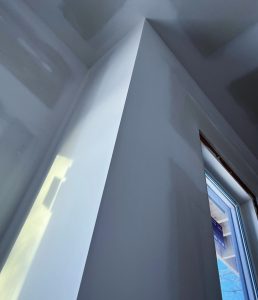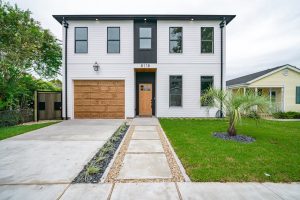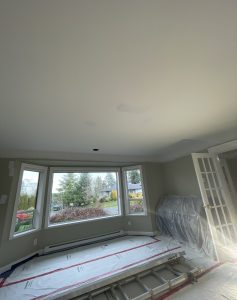Drywall installation is a pivotal phase in the construction process, shaping the aesthetics and structural foundation of a building’s interior. While it is a standard practice, it comes with its unique set of challenges that demand the attention and expertise of professionals. This essay will comprehensively explore the multifaceted challenges encountered in drywall installation and delve into the innovative solutions that have emerged to overcome these hurdles.
The Crucial Role of Drywall:
Before delving into the challenges and solutions, it’s essential to understand the significance of drywall in construction. Drywall, also known as gypsum board or plasterboard, is a widely used building material that serves as an interior wall and ceiling surface. Its popularity stems from its versatility, cost-effectiveness, and fire-resistant properties. In essence, drywall provides the canvas upon which the final touches of interior design are executed.
Common Challenges in Drywall Installation:
Uneven Surfaces:
The challenge of dealing with uneven surfaces during drywall installation is ubiquitous. Construction sites seldom offer perfectly level walls or ceilings, and achieving a smooth finish becomes challenging. The traditional approach of using a straightedge may not suffice, especially in large-scale projects where precision is paramount.Moisture and Mold Issues:
Moisture infiltration poses a significant threat to the integrity of drywall. In areas prone to high humidity or water leaks, the material becomes susceptible to damage, leading to mold growth and compromising structural stability. Addressing these issues is crucial to ensuring the longevity of the building.Cracking and Nail Pops:
Over time, structural settling, temperature changes, or insufficient fastening during installation can contribute to cracks and nail pops in drywall. These imperfections not only compromise the visual appeal but also raise concerns about the structural soundness of the installation.Difficult Angles and Corners:
Architectural designs often incorporate intricate angles and corners, posing a challenge during drywall installation. Achieving a seamless finish in these areas demands a high level of skill, precision, and sometimes, innovative solutions to navigate complex geometries.Sound Transmission:
In environments where sound insulation is critical, such as residential buildings, offices, or entertainment venues, the challenge of sound transmission through drywall becomes apparent. Overcoming this challenge is essential to creating comfortable and acoustically optimized spaces.
Innovative Solutions:
Advanced Laser Leveling Systems:
To counter the challenge of uneven surfaces, advanced laser leveling systems have become indispensable tools in the drywall installer’s arsenal. These systems use laser technology to provide accurate measurements, allowing professionals to identify and address unevenness with precision, ensuring a level surface for drywall installation.Moisture-Resistant Drywall Materials:
Manufacturers have responded to moisture-related challenges by developing specialized moisture-resistant drywall materials. These materials, often incorporating water-resistant additives or facing materials, help mitigate the risk of water damage and mold growth, particularly in areas prone to moisture, such as bathrooms and basements.Flexible Joint Compounds:
Addressing the issue of cracking and nail pops has seen the introduction of flexible joint compounds. These compounds, designed to accommodate the natural settling of a building, provide flexibility and resilience. By moving with the structure, they reduce the likelihood of cracks and nail pops, contributing to a more durable and visually appealing finish.Prefabricated Drywall Panels:
Navigating difficult angles and corners has been made more manageable with the advent of prefabricated drywall panels. These panels are manufactured off-site to precise specifications, ensuring that the intricacies of complex architectural designs are captured accurately. Prefabricated panels streamline the installation process, offering a more efficient and accurate solution for challenging geometries.Acoustic Drywall for Soundproofing:
In response to the challenge of sound transmission, specialized acoustic drywall has gained prominence. These materials are designed with soundproofing features, offering enhanced performance in reducing sound transfer between spaces. Acoustic drywall is particularly valuable in creating quieter and more comfortable living or working environments, meeting the increasing demand for acoustically optimized spaces.
The Evolution of Drywall Installation Practices:
The challenges and solutions in drywall installation are not static; they evolve with advancements in technology, materials, and construction practices. In recent years, several trends have shaped the way professionals approach drywall installation, further enhancing efficiency and quality.
Digital Modeling and Virtual Reality:
The integration of digital modeling and virtual reality tools has revolutionized the planning phase of drywall installation. Professionals can now create detailed digital models of the space, allowing them to identify and address potential challenges before the physical installation begins. Virtual reality simulations enable a more immersive and accurate understanding of the project, minimizing the risk of errors during construction.Smart Building Materials:
The emergence of smart building materials has extended to the realm of drywall. Intelligent materials equipped with sensors and responsive features contribute to enhanced functionality. For example, smart moisture sensors embedded in drywall can provide real-time feedback on environmental conditions, enabling proactive measures to prevent moisture-related issues.Robotics in Construction:
The integration of robotics in construction, although still in its early stages, holds promise for addressing labor-intensive aspects of drywall installation. Robotic systems capable of precise measurements and automated installation processes have the potential to increase efficiency and reduce the manual workload, especially in large-scale projects.Sustainable Practices:
Sustainability is a growing concern in the construction industry, and drywall installation is no exception. The development of sustainable and eco-friendly drywall materials aims to minimize the environmental impact of construction projects. From recycled content in gypsum boards to the use of environmentally friendly adhesives, the industry is gradually shifting towards more sustainable practices.
Safety Considerations in Drywall Installation:
In the pursuit of addressing challenges and implementing innovative solutions, the importance of safety in drywall installation cannot be overstated. Construction sites are inherently hazardous environments, and drywall installation involves specific risks that demand careful attention.
Respiratory Protection:
The sanding and finishing processes in drywall installation generate fine dust particles that pose respiratory hazards. Professionals must use appropriate respiratory protection, such as dust masks or respirators, to mitigate the risk of inhaling harmful particles.Ergonomics and Musculoskeletal Health:
The physical demands of lifting and positioning drywall sheets, as well as repetitive motions during installation, can contribute to musculoskeletal issues. Implementing ergonomic practices, such as using lifting aids and maintaining proper body mechanics, is essential to safeguard the health of workers.Fall Prevention:
Drywall installation often involves working at heights, especially when installing ceiling panels. Ensuring proper fall prevention measures, such as the use of scaffolding, guardrails, or personal fall arrest systems, is critical to minimizing the risk of falls and associated injuries.Tool Safety:
The tools used in drywall installation, including power tools for cutting and fastening, pose potential hazards. Training on proper tool use, regular equipment inspections, and adherence to safety guidelines are crucial to preventing accidents and injuries on the construction site.
Economic Considerations in Drywall Installation:
Beyond the technical and safety aspects, economic considerations play a significant role in the landscape of drywall installation. Construction projects must adhere to budget constraints while delivering high quality results. In this section, we will explore the economic factors associated with drywall installation, including material costs, labor expenses, and overall budgeting considerations for construction projects.
Material Costs: The economic considerations of drywall installation begin with material costs. Gypsum boards, joint compounds, adhesives, and other necessary materials contribute to the overall budget of a construction project. The price of these materials can fluctuate based on market conditions, demand, and the specific requirements of the project.
In recent years, there has been a focus on developing cost-effective yet high-quality materials for drywall installation. Manufacturers are continually innovating to create products that balance affordability with performance. Additionally, the sustainability movement has influenced material choices, leading to the development of eco-friendly options that align with both environmental and economic considerations.
Builders and project managers must carefully evaluate material options based on project specifications and budget constraints. While it’s essential to choose cost-effective materials, compromising on quality can result in long-term issues and additional expenses. Striking the right balance between cost and quality is a key aspect of successful budget management in drywall installation.
Labor Expenses: Labor is a significant component of the economic landscape in drywall installation. Skilled workers, including drywall installers, finishers, and supervisors, contribute to the successful completion of a project. The cost of labor includes wages, benefits, and potentially overtime pay, all of which impact the overall project budget.
The efficiency and expertise of the labor force play a crucial role in determining project timelines and, consequently, labor costs. Experienced drywall professionals are often more efficient in handling challenges, resulting in quicker installations and potentially lower labor expenses.
In recent years, there has been a growing emphasis on workforce development and training in the construction industry. Investing in the skills and knowledge of workers not only enhances the quality of drywall installation but can also contribute to cost savings by reducing errors and improving efficiency.
Budgeting Considerations: Effective budgeting is essential for the success of any construction project, and drywall installation is no exception. Construction budgets must account for material costs, labor expenses, equipment rentals, safety measures, and potential unforeseen challenges.
Accurate Cost Estimation: Accurate cost estimation is the foundation of effective budgeting. Builders and project managers must conduct thorough assessments to determine the quantity of materials required, labor hours, and potential risks. Utilizing historical data, industry benchmarks, and input from experienced professionals can contribute to more precise cost estimates.
Contingency Planning: Unforeseen challenges are inevitable in construction projects, and drywall installation is no exception. Including a contingency fund in the budget allows for flexibility in addressing unexpected issues without jeopardizing the overall project timeline or quality. A common practice is to allocate a percentage of the total budget as a contingency, typically ranging from 5% to 10%.
Technology Integration for Cost Management: The integration of technology in construction project management has transformed cost tracking and control. Software tools and platforms are available to help project managers monitor expenses, track progress, and identify areas where adjustments can be made to stay within budget. Real-time data and analytics contribute to informed decision-making and proactive cost management.
Lifecycle Cost Analysis: Beyond initial construction costs, builders are increasingly considering the lifecycle costs of materials and installations. This approach involves evaluating the long-term performance, maintenance requirements, and energy efficiency of materials. While certain materials may have higher upfront costs, their durability and sustainability may result in lower overall costs over the life of the building.
Value Engineering: Value engineering involves optimizing the functionality and quality of a project while minimizing costs. This approach requires collaboration among architects, engineers, and construction professionals to identify opportunities for cost savings without compromising performance. In the context of drywall installation, value engineering may involve exploring alternative materials, construction methods, or finishes that provide cost-effective solutions.
Sustainable Construction Practices: Sustainable construction practices not only align with environmental goals but can also contribute to economic efficiency. Energy-efficient building designs, the use of recycled materials, and sustainable construction practices can lead to reduced operational costs over the life of the building.
Contractual Agreements and Negotiations: The contractual agreements between stakeholders, including contractors, subcontractors, and suppliers, play a crucial role in determining costs. Negotiating favorable terms, ensuring transparency in pricing, and clarifying responsibilities can help prevent budgetary surprises and disputes during the construction process.
Conclusion: Drywall installation, while a fundamental aspect of interior construction, is a complex process that involves navigating various challenges. From addressing uneven surfaces to managing economic considerations, professionals in the construction industry continually seek innovative solutions to enhance efficiency, safety, and overall project success.
In the economic realm, effective budgeting is paramount to the success of any construction project. Balancing material costs, labor expenses, and unforeseen challenges requires careful planning, accurate estimation, and the integration of technology for cost management. As the construction industry evolves, the incorporation of sustainable practices, value engineering, and a holistic approach to lifecycle costs is becoming increasingly integral to economic considerations in drywall installation.
In conclusion, the journey of drywall installation is not only about overcoming challenges but also about embracing opportunities for innovation and improvement. By addressing the multifaceted aspects of the process, from technical challenges to economic considerations, the construction industry can continue to elevate the standards of drywall installation and contribute to the creation of resilient, efficient, and aesthetically pleasing built environments.






